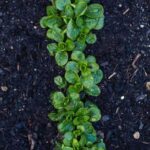Vegetable gardening has long been a beloved hobby for many, providing not only fresh and nutritious produce but also a sense of fulfillment and connection to the natural world. However, there is a common misconception that vegetable gardening requires full sun exposure, leaving those with shaded yards feeling limited.
In reality, shade gardening can be just as rewarding and fruitful as its sun-drenched counterpart. This article aims to shed light on the importance of vegetable gardening with shade and debunk any misconceptions surrounding this unique gardening approach.
One of the key benefits of vegetable gardening in shaded areas is the ability to extend the growing season. While direct sunlight is crucial for some plants, others actually thrive in cooler and shadier conditions.
Shade-loving vegetables can not only tolerate less sunlight but can even benefit from it, as they are less prone to stress and have an increased resistance to pests and diseases. By embracing shade gardening, you can enjoy a wider variety of crops throughout the year and make the most of your garden space.
It is important to address the common misconceptions about the limitations of shade gardening. Many believe that shaded areas lack adequate light for plant growth or that vegetables grown in shady conditions will be stunted or unproductive.
However, with proper planning and selection of shade-tolerant varieties, it is possible to achieve a bountiful harvest even in shaded spots. Understanding different types of shade, assessing your garden space, choosing suitable vegetables, preparing the soil, managing light levels, watering efficiently, and controlling pests and diseases are all essential aspects that will be explored in this article to help you create a thriving shade garden.
Assessing Your Shaded Garden Space
When starting a vegetable garden in a shaded area, it is important to assess your garden space to determine the best planting locations and optimize plant growth. Understanding the different types of shade and their impact on plant growth is essential for successful gardening. There are three types of shade: light shade, partial shade, and full shade.
Light shade refers to areas where sunlight is partially obstructed or dappled throughout the day. This type of shade allows for some direct sunlight to reach the plants, but at a reduced intensity. Partial shade refers to areas that receive only a few hours of direct sunlight each day, typically in the morning or afternoon. Full shade refers to areas that receive no direct sunlight and are in constant shade throughout the day.
To assess your shaded garden space, start by mapping out the different levels of shade within your garden area. Observe the patterns of sunlight throughout the day and note which areas receive direct sunlight and which areas are constantly shaded. This will help you determine where certain vegetables should be planted based on their specific light requirements.
In addition to assessing the levels of shade, evaluate other environmental factors such as soil quality and drainage. Some shaded areas may have poor soil fertility or retain excessive moisture due to lack of sunlight drying out the soil properly. It is important to prepare your soil and improve its fertility before planting your vegetable garden.
By properly assessing your shaded garden space, you can make informed decisions about where to plant certain vegetables and ensure optimal growth and productivity. Understanding the unique conditions of your shaded area will help you create a successful and thriving vegetable garden.
Selecting Shade-Tolerant Vegetables
When it comes to vegetable gardening in shaded areas, selecting the right vegetables is crucial for a successful harvest. While some plants may struggle to thrive without ample sunlight, there are many shade-tolerant varieties that can still produce abundant yields. By choosing the right vegetables and understanding their ideal planting requirements, you can create a bountiful garden even in areas with limited sunlight.
One important aspect of selecting shade-tolerant vegetables is understanding the different levels of shade and their impact on plant growth. Light shade refers to areas where there is filtered sunlight throughout the day, while partial shade refers to spots that receive a few hours of direct sunlight but are mostly shaded.
Full shade refers to areas that receive no direct sunlight at all. Understanding the level of shade in your garden will help you choose vegetables that are adapted to those conditions.
There are various vegetables that thrive in shaded conditions and can provide you with a diverse selection of produce. Leafy greens like lettuce, spinach, and kale are excellent choices for shady gardens as they require less direct sunlight compared to other vegetables. Root crops such as beets, radishes, and carrots also tolerate light shade well. Additionally, herbs like parsley, cilantro, and mint flourish in partially shaded areas.
| Vegetable | Ideal Sunlight Requirements | Planting Depth | Spacing |
|---|---|---|---|
| Lettuce (various types) | Partial Shade | 1/4 inch deep | 6-12 inches apart |
| Spinach | Partial Shade | 1/2 inch deep | 6-8 inches apart |
| Kale | Partial Shade to Full Sun | 1/4 inch deep | 12-18 inches apart |
Remember that while these vegetables are shade-tolerant, they still require some sunlight to thrive. It is important to find spots in your shaded garden that receive at least a few hours of direct or filtered sunlight each day. By selecting the right vegetables and providing them with suitable planting conditions, you can enjoy a fruitful harvest even in the shadiest parts of your garden.
Preparing Soil and Drainage for Shaded Gardens
Importance of Soil Preparation in Shaded Gardens
Proper soil preparation is essential for successful vegetable gardening in shaded areas. Shaded gardens often have different soil conditions compared to sunny areas, and addressing these differences can greatly improve plant growth and overall garden productivity.
In shaded gardens, the lack of direct sunlight can lead to more moisture retention in the soil, which can potentially cause issues with drainage and nutrient availability. Therefore, it is important to take the necessary steps to enhance soil fertility and moisture management in order to create optimal growing conditions for shade-tolerant vegetables.
Enhancing Soil Fertility
One key aspect of soil preparation for shaded gardens is enhancing soil fertility. Without adequate sunlight, plants cannot rely on photosynthesis alone to produce the energy they need for growth. As a result, it is crucial to provide them with sufficient nutrients in the soil.
Incorporating organic matter such as compost or well-rotted manure into the soil before planting can significantly improve its fertility. Organic matter not only adds nutrients but also enhances the structure of the soil, allowing for better root development and nutrient uptake by plants.
In addition to organic matter, applying a balanced fertilizer specifically formulated for vegetables can help supplement any nutrient deficiencies that may be present in shaded soils. Prior to planting, it is recommended to conduct a soil test to determine the specific nutrient needs of your garden. This will provide you with valuable information on which nutrients are lacking so that you can select an appropriate fertilizer or amendment.
Managing Moisture Retention
The high moisture levels typically found in shaded areas can pose challenges for proper drainage in vegetable gardens. Excess waterlogged soil can lead to root rot and other issues that negatively impact plant health. To avoid these problems, it is important to optimize drainage in your shaded garden.
One effective method of improving drainage is by incorporating organic matter into the soil, as mentioned earlier. Organic matter helps improve the soil structure, allowing excess water to drain more easily. Another technique is to create raised beds or mounds in your shaded garden. These raised areas can promote better drainage by elevating the plants above the moist ground.
Furthermore, it may be necessary to monitor and adjust watering practices to prevent excessive moisture retention in the soil. Shaded gardens typically require less water than sunnier areas because of reduced evaporation rates. Regularly check the moisture levels in your soil and only water when necessary. This will help maintain optimal moisture levels without overwatering your shade-loving vegetables.
Designing a Shaded Garden Layout
When it comes to designing a shaded garden layout, there are several factors to consider in order to maximize space and sunlight for your shade-tolerant vegetables. Despite the challenges that come with gardening in shaded areas, with careful planning and strategic placement of plants, you can create a thriving and productive garden.
One important aspect to consider is the layout options available for your shaded garden. One option is to create raised beds or containers that can be moved around to take advantage of available sunlight throughout the day. This allows you to adjust the positioning of your plants as needed to optimize their exposure to sunlight.
Another layout option is companion planting, which involves grouping plants together based on their compatibility and sun/shade requirements. For example, taller plants can provide shade for shorter ones, while leafy vegetables like lettuce or spinach can benefit from the filtered light provided by larger, shade-casting plants. By strategically arranging your plants in this way, you can make the most of the available sunlight and create a visually appealing garden.
In addition to layout considerations, there are also various techniques you can employ to manage shade and light levels in your shaded garden. One option is strategic pruning of nearby trees or shrubs that may be casting excessive shade on your vegetable beds. By selectively removing branches or thinning out foliage, you can allow more sunlight to reach your plants.
Reflective surfaces can also be used in shaded gardens to increase the amount of sunlight reaching your plants. Placing reflective materials such as mirrors or aluminum foil on fences or walls adjacent to your vegetable beds can redirect and amplify sunlight onto your crops.
By carefully considering layout options and employing techniques for managing shade and light levels, you can design a shaded garden that maximizes sun exposure for your shade-tolerant vegetables. With some creativity and planning, even heavily shaded areas can be transformed into bountiful and beautiful vegetable gardens.
Managing Shade and Light Levels
One of the key challenges in vegetable gardening with shade is managing the levels of shade and light in your garden. Different plants have varying requirements for sunlight, so it’s important to find a balance that will promote healthy growth and productivity. Here are some techniques you can use to effectively manage shade and light levels in your shaded garden:
- Strategic Pruning: One way to manage shade and light levels is by strategically pruning surrounding trees or plants. By selectively removing branches or foliage, you can allow more sunlight to reach your shaded garden beds. It’s important to research the specific pruning requirements for each plant, as improper pruning can damage or weaken them.
- Reflective Surfaces: Another method to increase the amount of sunlight reaching your shaded vegetables is by using reflective surfaces. Placing reflective materials, such as aluminum foil or mirrors, around your garden can help redirect and reflect sunlight onto your plants.
- Shade Cloth and Other Shading Devices: While the goal of shade gardening is to provide partial or filtered sunlight, sometimes excessive shade can hinder plant growth. In these cases, using shade cloth or other shading devices can be beneficial. Shade cloth comes in different densities and can be draped over support structures like poles or hoops to provide additional shade when needed.
Managing shade and light levels is crucial for optimizing plant growth in a shaded vegetable garden. Through strategic pruning techniques, the use of reflective surfaces, and utilizing shading devices like shade cloth, you can create an environment that provides just the right amount of sunlight for your plants’ needs.
It’s important to monitor the light conditions in your garden regularly and make adjustments as needed throughout the day and growing season as the angle of the sun changes. By paying attention to these factors, you’ll be able to create an ideal environment for your shaded vegetable garden and maximize its productivity.
Watering and Irrigation in Shaded Vegetable Gardens
Watering and irrigation play a crucial role in the success of any vegetable garden, and shaded gardens are no exception. However, gardening in shaded areas can present unique challenges when it comes to watering and maintaining proper soil moisture levels. In this section, we will address these challenges and provide tips for proper watering techniques in shaded vegetable gardens.
One of the main challenges in shaded gardens is ensuring that plants receive enough water without overwatering them. Since shade reduces evaporation, the soil tends to retain more moisture. It is important not to let the soil become too saturated, as this can lead to root rot and other fungal diseases. To prevent overwatering, it is crucial to monitor soil moisture levels regularly.
Here are some helpful tips for watering and irrigation in shaded vegetable gardens:
1. Use a moisture meter: A moisture meter is a handy tool that can help you determine when it’s time to water your plants. Insert it into the soil at various depths to get an accurate reading of the moisture level.
2. Water deeply but infrequently: Instead of frequently watering shallowly, water your vegetables deeply but less often. This encourages deeper root growth and helps plants better withstand dry periods.
3. Mulch your plants: Apply a layer of organic mulch around your plants to help retain soil moisture. Mulch also helps regulate soil temperature and suppress weed growth.
4. Avoid overhead watering: Overhead watering can increase humidity levels and create a favorable environment for fungal diseases. Instead, use drip irrigation or soaker hoses that deliver water directly to the base of plants.
5. Adjust watering frequency based on weather conditions: Shaded gardens may require less frequent watering than sunny ones since they receive less direct sunlight and evaporation is reduced. However, during hot spells or drought periods, monitor your plants’ moisture needs closely and adjust your watering schedule accordingly.
With proper attention to watering and irrigation, your shaded vegetable garden can thrive and produce a bountiful harvest. By following these tips, you can ensure that your plants receive the right amount of water for optimal growth while avoiding common pitfalls associated with overwatering or underwatering. Next, we will explore pest and disease management specific to shade gardening.
Pest and Disease Management for Shade Gardening
One of the challenges that shade gardeners may face is managing pests and diseases that can affect shade-tolerant vegetables. While shaded areas tend to have less pest pressure compared to sunny gardens, it is still important to be vigilant and take proactive measures to protect your plants. By implementing effective pest and disease management strategies, you can ensure the health and productivity of your shade garden.
Identifying common pests and diseases is an essential step in managing them effectively. Some pests that are known to affect shade-tolerant vegetables include slugs, snails, aphids, and caterpillars. These garden invaders can cause damage by eating foliage, tunneling into fruits, or spreading diseases. Similarly, certain diseases like powdery mildew or fungal infections can thrive in shaded environments with high humidity levels.
To prevent these issues, practicing good garden hygiene is crucial. Regularly remove any fallen leaves or plant debris from your shaded vegetable beds as they can harbor pests and pathogens. It is also beneficial to rotate crops each year to reduce the risk of disease buildup in the soil. This prevents pathogens from infecting new plants of the same family each growing season.
Another effective pest management technique is encouraging beneficial insects into your shaded garden space. Beneficial insects like ladybugs and lacewings prey on common garden pests such as aphids, helping to keep their populations in check naturally. You can attract these helpful creatures by incorporating flowering plants into your shade garden design.
In terms of disease control, providing appropriate air circulation is key. Prune overhanging branches or nearby vegetation that may limit airflow within your shaded garden space. This helps minimize excess moisture levels that contribute to fungal growth. Additionally, watering at soil level rather than overhead will help keep foliage dry and reduce the chances of fungal infections.
By implementing these pest and disease management strategies for your shade garden, you can create a healthy environment for your vegetables to thrive. Regular monitoring and early intervention will help mitigate any issues before they become severe. With proper care and attention, you can enjoy a bountiful harvest from your shade-tolerant vegetable garden.
Harvesting and Enjoying the Fruits of Your Shade Garden
Knowing When to Harvest
Once your shade-tolerant vegetables have reached maturity, it is important to harvest them at the optimal time. One of the challenges with shaded gardens is that plants may take longer to ripen compared to those grown in full sun. However, you can monitor the progress by observing the vegetable’s color, size, and overall appearance.
For example, leafy greens like spinach and kale are best harvested when the leaves are young and tender. Radishes should be pulled from the ground when they reach their desired size, while tomatoes should be picked when they are fully ripe but before they become too soft.
Culinary Ideas for Shade Garden Produce
One of the joys of vegetable gardening is being able to savor the fruits of your labor in a variety of delicious dishes. Shade garden produce can add unique flavors and textures to your meals. Leafy greens such as lettuce, Swiss chard, and arugula can be used in fresh salads or sautéed as a side dish. Radishes can add a refreshing crunch to sandwiches or salads.
Tomatoes from your shaded garden can be used in sauces, salsas, or simply enjoyed on their own. Don’t forget about herbs. Herbs like cilantro, parsley, and basil thrive in partially shaded areas and can enhance the flavor of many dishes.
Preserving Your Harvest
If you find yourself with more produce than you can consume immediately, there are several methods for preserving your harvest so you can enjoy it throughout the year. Leafy greens can be blanched and frozen for later use in soups or stir-fries. Tomatoes can be made into sauces or canned whole for use in various recipes.
Herbs can be dried by hanging them upside down in bunches or using a food dehydrator. Another option is pickling vegetables like radishes, cucumbers, or peppers to create tasty homemade pickles. By preserving your shade garden produce, you can continue to enjoy the flavors of your hard work even when the growing season has passed.
Remember to experiment and get creative with your shade garden harvest. Try new recipes, share your bounty with friends and neighbors, or even consider selling some of your surplus at a local farmer’s market. The possibilities are endless, and the satisfaction of enjoying homegrown vegetables from your shaded garden is truly rewarding. Embrace the unique flavors and possibilities that come with gardening in shaded areas, and let your culinary creations showcase the true potential of shade-tolerant vegetables.
Conclusion
In conclusion, vegetable gardening with shade offers a wealth of opportunities for gardeners to embrace and explore. Despite common misconceptions about the limitations of shade gardening, it is important to recognize the numerous benefits and creative possibilities that come with growing vegetables in shaded areas.
By assessing the shaded garden space, selecting shade-tolerant vegetables, preparing the soil and drainage, designing a suitable layout, managing shade and light levels, addressing watering challenges, and implementing effective pest and disease management techniques, gardeners can successfully cultivate a thriving shade garden.
While it may require some additional attention and care compared to gardening in sunnier areas, the satisfaction and rewards of successful shade vegetable gardening are well worth the effort. As you harvest the delicious produce from your shade garden, you will not only enjoy the taste of your hard work but also appreciate the unique flavors that shade-grown vegetables offer.
Plus, with an abundance of fresh ingredients at hand, you can explore various culinary creations and experiment with new recipes that showcase the flavors of your homegrown produce.
By embracing the challenges and opportunities that come with gardening in shaded areas, you have the chance to exercise your creativity and enhance your gardening skills. Whether you have a small balcony or a spacious backyard shaded by trees or structures, there is a shade-tolerant vegetable variety that will thrive in your specific conditions. So take advantage of this exciting opportunity to create a beautiful and productive shade garden that brings joy throughout the growing season.

If you’re looking to get into vegetable gardening, or are just looking for some tips on how to make your current garden better, then you’ve come to the right place! My name is Ethel and I have been gardening for years. In this blog, I’m going to share with you some of my best tips on how to create a successful vegetable garden.





